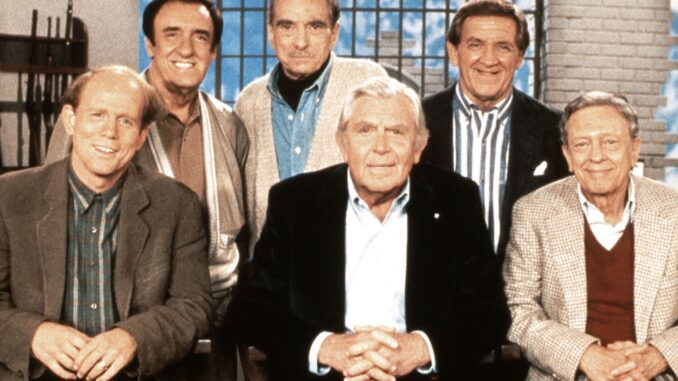
When The Andy Griffith Show first aired in 1960, the trend with many programs at that time was to film in front of a live audience.
The show’s star, Andy Griffith, a very hands-on actor, wasn’t sold on the idea of shooting in front of an audience and nixed it from the start, choosing instead to develop a show that wasn’t dependent on an audience’s laughs .
Clearly, it worked for the comedy that today remains a beloved classic.
Ron Howard recalled performing in front of a live audience for the ‘Griffith Show’s pilot episode
One of the show’s characters by Griffith’s side from the start was 6-year-old Ron Howard. Now a celebrated director, Howard spoke about shooting the pilot in a conversation with the Television Academy Foundation.
“I don’t remember anything like an audition for The Andy Griffith Show,” Howard said. “I just remember doing the first pilot on The Danny Thomas Show. That was done in front of an audience. It was the first time I remember being in front of an audience. But it didn’t seem to bother me.”
If you watch Howard’s performance on that pilot episode, you’d have to agree with him: he was an absolute natural in front of an audience.
“I liked it, I just liked it,” he said. “Blessing, complete blessing. I thought it was fun. When I got a little older, once in a while, I thought it would be a drag having to learn the lines. I was having a lot of fun.”

Why Griffith refused to have a live audience
The show’s pilot episode on The Danny Thomas Show must have influenced Griffith’s preference against working with an audience. After that, it seems, he made up his mind to do without in-person viewers.
“With a three-camera show, you’re doing it with an audience, you understand,” Griffith told PBS’ Pioneers of Television. “So, it’s written with the audience in mind. That is, jokes spaced around, so that you get that reaction from the audience.”
The Andy Griffith Show was shot instead with one camera, which Griffith explained was a deliberate decision.
“With one camera, you don’t have to do that,” he said. “We don’t have an audience. So, Don [Knotts] and I could do these little quiet scenes or me and Ronny or me and Aunt Bee or Floyd the Barber, any of us, we could do these long, little, nice scenes without having to go for a joke. Some of them didn’t have any jokes at all, some of them did.”
Griffith reluctantly agreed to laugh tracks
Griffith was pressured by the show’s producers to put a laugh track to use on the 1960 comedy. The star wasn’t fond of canned laughter and asked instead that one of the show’s episodes be screened to a live audience, and then have that laughter used as a laugh track. The idea was given a shot but didn’t really take, according to Andy and Don: The Making of a Friendship and a Classic American TV Show author Daniel de Visé.
“Andy persuaded the Griffith producers to try an experiment: screen a filmed episode before a live audience, record the laughter, and add it to the tape before broadcast,” the biographer wrote. “A few early Griffith episodes were broadcast with “live” laugh tracks before the network pulled the plug on Andy’s costly experiment. He and the producers reached a sort of compromise: Griffith would use a laugh track, but sparingly.”
